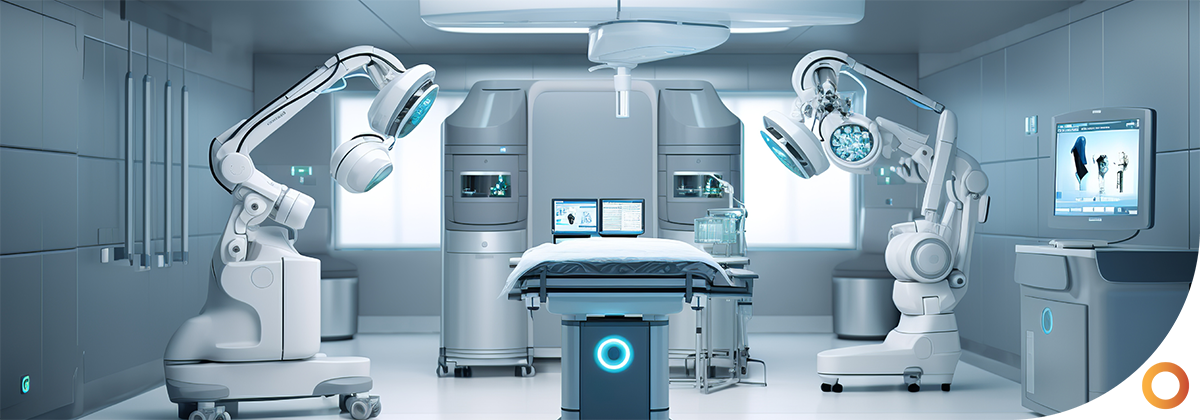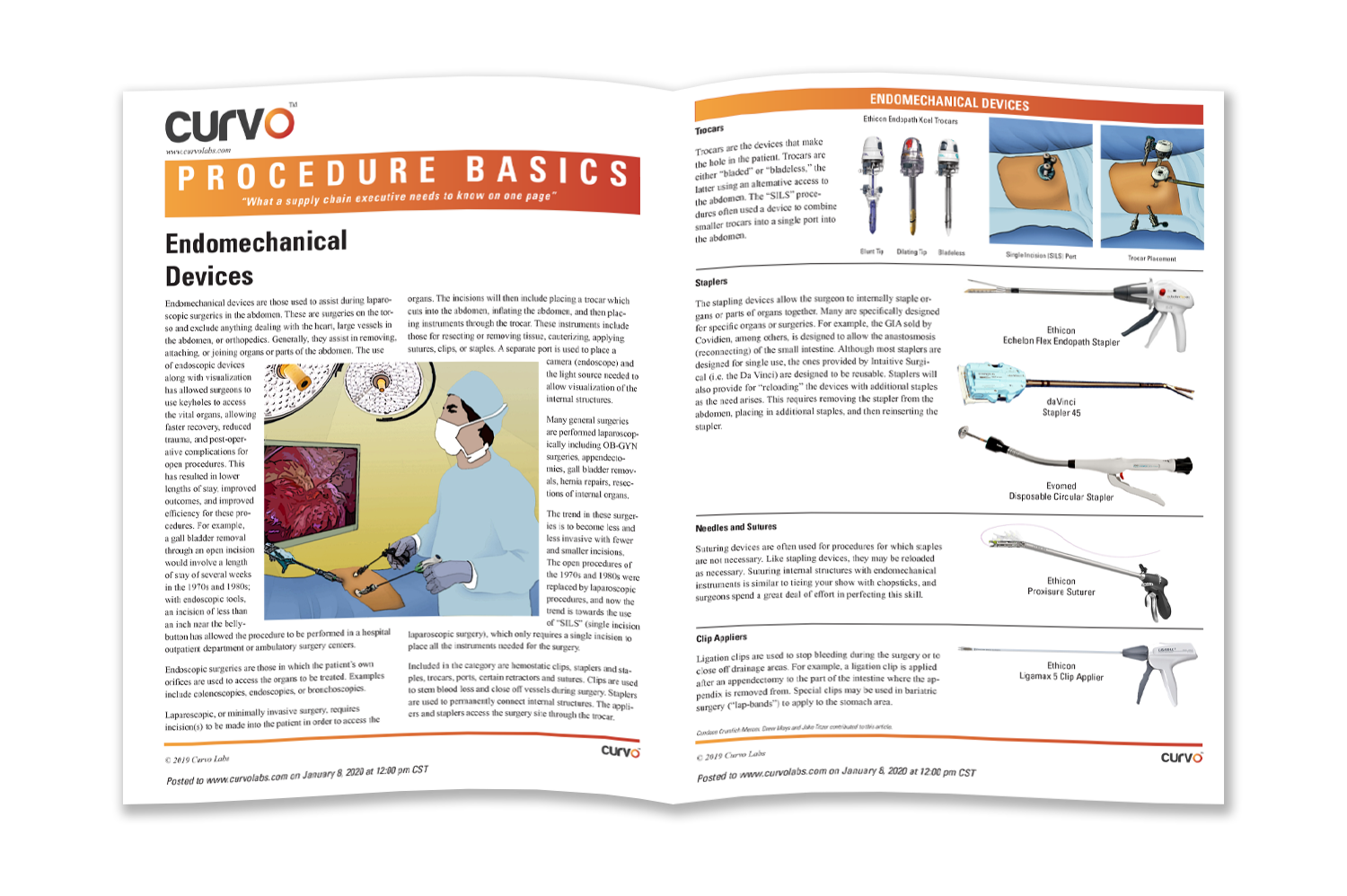Home Blog Part 1: Overview of Endomechanical Sourcing

Part 1: Overview of Endomechanical Sourcing
Supply Chain Medical Devices Strategic Sourcing

Randolph Williams
Randolph Williams has been an observer and a participant in the endomechanical space for over 30 years. He’s been through the “stapler wars” and the laparoscopic years, and now is witness to disposables, reusables and robotics in the operating rooms.
To Williams, the mission has always been about changing techniques and devices to get better healing. “Encouraging adoption and acceptance of “minimally invasive procedures” can result in faster healing and shorter hospital stays,” he noted. This article includes his insights and advice around endomechanical sourcing and the healthcare supply chain.
How Endo Differs from Other Medical Device Contracts
Endomechanical contracts are different from other types of device contracts. Ways this high-ticket sourcing differs from other types include:
- Variety of instruments
- Tied to Suture and Vessel Sealing in some cases
- Involves Physician Preference Items (PPI)
Endomechanical contracts often represent significant spend for healthcare systems, often in the top five in medium to large hospitals.
What Makes Endomechanical Sourcing So Hard?
There are several reasons the thought of a new endomechanical contract fills the healthcare supply chain with dread:
- Surgeon preference
- Two main players, many sub-category players
- Movement to robotic surgery
While notoriously difficult, endomechanical sourcing rewards those who work hard at it.
Impact of PPI on Endomechanical Sourcing Success
Whether an endomechanical device is considered a Physician Preference Item (PPI) depends on interpretation. The same type of instrument can be PPI in one circumstance or facility, and not considered PPI in another.
“The supply chain would love an endomechanical device to not be a PPI so it is easier to source. Unfortunately, there's still a strong preference in many cases, and that's driven by how physicians were trained. Surgeons trained by a certain company tend to stay loyal, especially if there are no adverse outcomes during their residency or fellowship.” – Randolph Williams
Endo Often Bundled with Other Clinical Products
Clinical product contracts involve these types of endomechanical devices:
- Staplers – Open and Laparoscopic
- Endoscopic Endonasal Approach (EEA)
- Trocars
- Laparoscopic – Handhelds such as graspers, suturing devices, clamps
“Endo is normally a category of its own, but a lot of times, Endo is bundled with Suture and Vessel Sealing,” Williams explained. “You can have a laparoscopic instrument, and you need a suturing device – it just becomes such a difficult dynamic. However, supply chain leaders have done a great deal of due diligence to remove Suture and its ties to endomechanical sourcing as of late.”
Rebates: Common and High-Impact
Corporate rebates are common in Endo, and dollar volume is normally high. Rebates are impactful, and that's a big factor in Endo sourcing.
“Endo is often on a rebate agreement with Vessel Sealing and Suture. You normally have to convert all three or at a minimum two,” he said. “So you're taking a big category and tying it to another big category.” That starts to dip into the compliance that usually is driven by the endomechanical piece.
“Imagine being the supply chain of a large university hospital system, and Medtronic has your endomechanical business. The spend is $4 million, and there’s a two to 5% rebate in place to maintain 90% compliance. So the hospital will get between two and 5% of $4 million annually or quarterly as a rebate. If you move outside of that 90% compliance, that rebate is in jeopardy, so it's like a price increase.”
Who Are the Players in Endo?
Williams cites the main endomechanical players as Ethicon, Medtronic (old US Surgical), Intuitive Surgical and Applied Medical.
“Today, there are two major players in the endomechanical space – Medtronic and Ethicon,” said Williams. “Ethicon has a leg up because they have a robust line of Suture, but this is less problematic with all the recent work from Supply Chain to remove Suture from mandatory bundling with Endomechanical. Then it comes down to other players.”
Robotics in Endomechanical Sourcing
“Intuitive Surgical – the largest robot company out there – is creeping into this space, and will soon be a solid number three. In probably nine to 12 months, they'll dominate in the robotic use of endomechanical. They're building their own instruments (through partnerships or their own manufacturing) that attach to the robot.”
The movement to robotic surgery makes Endo even more complicated and significant, because a hospital could spend between a million and $2 million dollars just on the robot. But it’s not just about the money. Williams pointed out that the introduction of less-invasive robotics in endomechanical surgery also contributes to faster healing and more consistent results.
Cross-Referencing Endomechanical Products
Williams pointed to the completeness of the Applied line, “The ability to cross-reference to the complete line of endomechanical products from Medtronic and Ethicon can hinder Applied, but their ability to segment Trocars gives them traction. Applied Medical is the only real competitor on all the Trocars/Bags, and they have a decent VSealer, but no Suture yet. So again, the market has this dynamic of Ethicon and Medtronic as the only ones that really have it all.”
“Medtronic and Ethicon are the only companies with complete cross references. Intuitive has a great platform, but lacks Suture, a complete endo portfolio, and Vessel Sealing is not complete. I think that’s coming,” said Willliams.
A number of niche players are coming with unique one-off products, and some are gaining attention with a reusable/disposable approach. Instead of all-disposable. It could be a reusable handle, and hospitals just pay for the disposable piece.
The Standardization Challenge in Endomechanical Sourcing
Product standardization gets tricky in Endo. “It's harder to get standardization when you have a robot using a different device that's a proprietary stapler. You start to lose some compliance. Then a Medtronic or an Ethicon says they have to raise your prices because you're not using 90% of their product,” Williams explained.
“You start to get into those dynamics, and that's why this is a tough category. I wouldn't say it's as difficult as hips and knees to get standardization, but it can be hard.”
Hard Facts About Endomechanical Contract Pricing
When hospitals source, it's based on compliance or volume, not your pricing. “Say you are trying to convert to another vendor, and you're 70% successful, meaning 70% compliance. The savings can still erode because of the price increase from the other supplier for trying to convert,” Williams explained.
In another example, an Ethicon hospital has 90% compliance, and then the hospital wants to move to Medtronic. They go through a two-month conversion and only get 70%. “First off, they might not get the price offered by Medtronic for only 70% usage. And number two, Ethicon will raise their prices heavily for the 30% the hospital now uses that used to be 90%,” said Williams.
“In that example, you convert away from whomever you're using for Vessel Sealing and Suture to a Medtronic that you're just trying to use for the endomechanical. But you're not successful. At 90% compliance, prices go up for Suture and Vessel Sealing, as well as the remaining 30% in endomechanical units from Ethicon.”
You Can Master Endomechanical Sourcing
If you’ve read this far, you must have more than the average interest in endomechanical sourcing. We’ve got more advice and ideas for you. Just reach out with any sourcing questions.
Watch for Part 2 in this series. Randy Williams offers more advice and explores solutions for endo sourcing.

